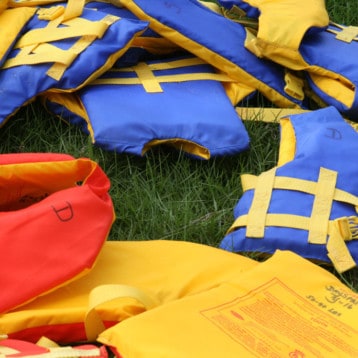Approximately 89 percent of sea deaths occur to people who were not wearing life jackets. The obvious solution: wear a life jacket. However, some life jackets may be too old or too worn out to operate correctly and others may just be too uncomfortable because they weren’t fitted correctly. No one wants a life jacket with a bunch of problems to fail in their time of need but, luckily some of these issues are easy fixes and usually require small touch ups or new parts.
How Long are Life Jackets Safe?
Life jackets last around a decade according to manufacturers. If the life jacket is in everyday use, that means that the equipment will need frequent replacement due to frequent usage. The expiration date is printed on the side of inflatable life jackets, but other life jackets doesn’t have exact expiration dates.
Most life jackets have a clearly printed expiration date meaning the canister of CO2 will run out and it will no longer float. Of course, it would be useless if that were to happen so when that date comes around, buy an extra canister to protect yourself and your loved ones. The canisters are pretty inexpensive, but some may prefer to just purchase another life jacket all together. Since we are on the topic of maintaining life jackets, the particularly inexpensive ones’ fabric tend to decay over time. A good way to prevent that is to make sure you store it out of the Sun since that is the cause.
Life jackets should be stored in cool, dry, dark places. The reason for this is that moistness over a long period of time will cause mildew will grow fast in those conditions. This can be detected just as easily as it grows because you will be able to smell the mold. To clean this, you’ll need to mix a half-and-half solution of water and hydrogen peroxide and scrub the mildew stained areas with a nylon scrubber. After you work that solution in, scrub it again with mild dish detergent and leave it to dry. This may sound counter-productive, but it is best to hang it to dry in a sunny area as it will help the process of taking the mildew out. As soon as it is completely dry, go ahead and bring it to that cool, dry, dark place you’ve reserved.
The last of the maintenance tips is what to do when a leak of air occurs in a life jacket. There are many remedies and the fact is, they won’t repair it completely and without risk. Since the point here is to make sure that there is no risk on the water, we recommend that the simple fix here is to just throw it away. It is actually better to cut it up before you throw it away so that you don’t allow someone else to take the risk and possibly lose a life because they depended on a faulty life jacket.
Life jacket maintenance is mostly common sense and involves easy fixes. The only other major issue is fitting, but there are entire guides just to say “don’t make it too tight.” Hopefully, when you and your family head out on your boat, check the expiration date before you go and make sure to store it in a cool, dark, dry place when you have had your fun. This way, you can ensure your life jacket stays functional and risk-free ready to save a life.





